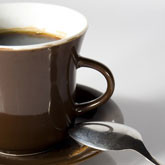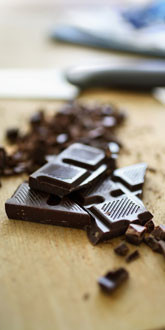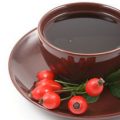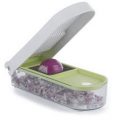 Caffeine in teaCaffeine enhances and regulatesexcitation processes in the cerebral cortex; in appropriate doses, it enhances positive conditioned reflexes and increases motor activity. The stimulating effect leads to increased mental and physical performance, decreased fatigue and drowsiness. Large doses can, however, lead to exhaustion of nerve cells. Caffeine weakens the effect of sleeping pills and narcotics, increases the reflex excitability of the spinal cord, excites the respiratory and vasomotor centers. Cardiac activity under the influence of caffeine increases, myocardial contractions become more intense and more frequent. If we do not take into account synthetic production, then caffeine can be obtained by extracting it from tea waste and coffee beans. In its usual form, caffeine is a white crystalline powder with a bitter taste, odorless. But you are unlikely to have seen it in this form, perhaps most often you have encountered it as a component of one of the products listed below. Caffeine is contained in such products as:
Caffeine in teaCaffeine enhances and regulatesexcitation processes in the cerebral cortex; in appropriate doses, it enhances positive conditioned reflexes and increases motor activity. The stimulating effect leads to increased mental and physical performance, decreased fatigue and drowsiness. Large doses can, however, lead to exhaustion of nerve cells. Caffeine weakens the effect of sleeping pills and narcotics, increases the reflex excitability of the spinal cord, excites the respiratory and vasomotor centers. Cardiac activity under the influence of caffeine increases, myocardial contractions become more intense and more frequent. If we do not take into account synthetic production, then caffeine can be obtained by extracting it from tea waste and coffee beans. In its usual form, caffeine is a white crystalline powder with a bitter taste, odorless. But you are unlikely to have seen it in this form, perhaps most often you have encountered it as a component of one of the products listed below. Caffeine is contained in such products as:
Of course, in everything you know andmuch respected coffee. The caffeine content in coffee varies depending on the dose, the type of coffee, the method of preparation (instant or brewed), etc., etc. The caffeine content in instant coffee is 61-70 mg/h, and in brewed coffee - 97-125 mg/h. Interestingly, caffeine is also present in the so-called "decaf coffee" (in small quantities, but it is still there).
You probably also know that caffeine containsin tea. It is present in both black and green tea. Moreover, green tea contains more caffeine than black tea, and young leaves contain more than old ones. The caffeine content in tea is about 15-75 mg/h.
The next drink, which contains caffeine, is cocoa. Since the caffeine content in cocoa is insignificant (10-17 mg / h), it is not as exciting for the human body as, for example, coffee.
Chocolate is also a caffeine-containing product.(One chocolate bar contains about 30 mg of caffeine). It is said that chocolate improves mood, and this is not surprising, since the caffeine contained in this product has a mild stimulating effect on the cardiovascular and nervous systems.
Caffeine is contained in plants such as: Caffeine in coffee
Caffeine in coffee
- Mate is a plant that is widespread inCentral and South America. The processed and dried leaves and stems are used as a herbal tea, which is widespread in South America and is gradually gaining popularity around the world. The drink has a bitter taste with a slightly sweet aftertaste, has a tonic effect, improves digestion and liver function, and some scientists have also noted the immunostimulating effect of the drink in their studies.
- Guarana is a climbing vine that grows wildnative to the Amazon region of Brazil and Uruguay. The guarana fruit is about the size of a hazelnut, deep yellow to orange in color, and splits open to reveal a single purple-brown or black seed. Traditionally, these seeds have been used to treat headaches, fever, cramps, as a stimulant, aphrodisiac, preventative against bacterial infections, and as a tonic.
Caffeine is also found in Coca-Cola.Of course, the nuances of the drink's proportions are kept a closely guarded secret by Coca-Cola and constitute a technological secret, but the main components (one of which is caffeine) are not a secret. The proportion of caffeine in the drink is about 14 mg per 100 g.
Caffeine is also present in energy drinks (Burn, Red Bull, …)
Some medicines also contain caffeine.(for example, Citramon, Kofitzl). In medicine, caffeine is used in infectious and other diseases, accompanied by inhibition of the central nervous system and the cardiovascular system, in case of poisoning with drugs and other poisons, which depress the central nervous system, during cerebral spasms (with migraine, etc.), to increase mental and physical health, to eliminate drowsiness. Caffeine is also used in children with enuresis.
Caffeine can also be present in beer.For example, Anheuser-Busch, famous for its beer under the Budweiser brand, produces B-to-the-E (BE) beer, which contains guarana and ginseng extracts. Guarana is also included in Molson Kick beer by Molson. Caffeine is also contained in Drive Max beer by Sarmat.
Interestingly, besides drinks and foodfood, caffeine contain and garments. Scientists invented caffeinated tights. On sale appeared tights, soaked in coffee. Experts say that this piece of clothing can reduce the circumference of the hips, get rid of cellulite, improve skin elasticity and improve its smoothness. The pantyhose fiber is saturated with caffeine microcapsules. Body temperature causes caffeine to act on the skin. Scientists have proven that the active ingredients of caffeine stimulate metabolism, help burn fats and tighten leg tissue.
There is also a series of shampoos with caffeine.complex. Thus, the company Alpecin (Germany) has released a series of shampoos containing caffeine, which directly affects the hair roots and directly counteracts the effects of testosterone (testosterone is harmful to hair, it affects hair roots and leads to their premature loss, that is, baldness).
Comments
comments
 Caffeine in teaCaffeine enhances and regulatesexcitation processes in the cerebral cortex; in appropriate doses, it enhances positive conditioned reflexes and increases motor activity. The stimulating effect leads to increased mental and physical performance, decreased fatigue and drowsiness. Large doses can, however, lead to exhaustion of nerve cells. Caffeine weakens the effect of sleeping pills and narcotics, increases the reflex excitability of the spinal cord, excites the respiratory and vasomotor centers. Cardiac activity under the influence of caffeine increases, myocardial contractions become more intense and more frequent. If we do not take into account synthetic production, then caffeine can be obtained by extracting it from tea waste and coffee beans. In its usual form, caffeine is a white crystalline powder with a bitter taste, odorless. But you are unlikely to have seen it in this form, perhaps most often you have encountered it as a component of one of the products listed below. Caffeine is contained in such products as:
Caffeine in teaCaffeine enhances and regulatesexcitation processes in the cerebral cortex; in appropriate doses, it enhances positive conditioned reflexes and increases motor activity. The stimulating effect leads to increased mental and physical performance, decreased fatigue and drowsiness. Large doses can, however, lead to exhaustion of nerve cells. Caffeine weakens the effect of sleeping pills and narcotics, increases the reflex excitability of the spinal cord, excites the respiratory and vasomotor centers. Cardiac activity under the influence of caffeine increases, myocardial contractions become more intense and more frequent. If we do not take into account synthetic production, then caffeine can be obtained by extracting it from tea waste and coffee beans. In its usual form, caffeine is a white crystalline powder with a bitter taste, odorless. But you are unlikely to have seen it in this form, perhaps most often you have encountered it as a component of one of the products listed below. Caffeine is contained in such products as: Caffeine in coffee
Caffeine in coffee








